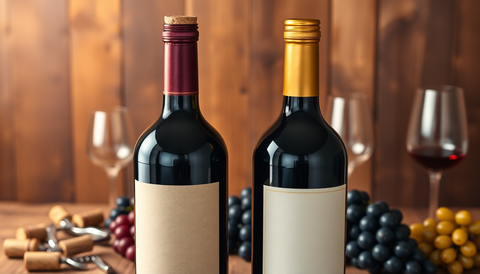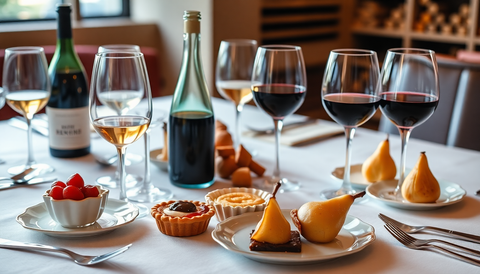In the captivating world of winemaking, there is one unsung hero that plays a pivotal role in transforming grapes into the nectar we so deeply cherish - yeast. While the grape itself is the foundation of any great wine, it is the intricate dance between the vine, the terroir, and the humble yeast that truly brings out the complexity and character of each vintage.
As we delve into the fascinating realm of winemaking, it becomes increasingly clear that yeast is not merely a passive participant, but rather an active collaborator in the creation of our favorite wines. From the delicate floral notes of a crisp Sauvignon Blanc to the robust, full-bodied character of a Cabernet Sauvignon, the influence of yeast is woven throughout the entire winemaking process.
The Yeast's Journey: From Vineyard to Bottle
The journey of yeast in winemaking begins in the vineyard, where the grapes are grown and nurtured. As the grapes ripen, they naturally accumulate a diverse array of yeasts on their skins, each with its own unique characteristics and contributions to the final wine. These wild yeasts, often referred to as indigenous or native yeasts, are the first to initiate the fermentation process when the grapes are crushed and their juices are exposed to the air.
However, in the modern era of winemaking, many producers opt to introduce specific strains of cultivated yeast, known as commercial or selected yeasts, to ensure a more controlled and predictable fermentation. These carefully selected yeasts are chosen for their ability to enhance specific flavor profiles, improve the wine's structure, and even contribute to the wine's overall stability and longevity.
The Alchemy of Fermentation
Once the grapes are crushed and the juice is exposed to the yeast, the magic of fermentation begins. The yeast, driven by its innate desire to consume the natural sugars present in the grape must, sets off on a remarkable transformation. Through a series of complex biochemical reactions, the yeast converts these sugars into alcohol, carbon dioxide, and a myriad of other compounds that contribute to the wine's aroma, flavor, and mouthfeel.
This fermentation process is a delicate dance, where the winemaker must carefully monitor and adjust the temperature, pH, and other environmental factors to ensure the yeast can thrive and perform its vital role. The choice of yeast strain, the timing of its introduction, and the management of the fermentation conditions all play a crucial role in shaping the final character of the wine.
The Yeast's Influence on Flavor and Aroma
As the fermentation progresses, the yeast not only converts the sugars into alcohol but also produces a vast array of secondary metabolites that contribute to the wine's unique flavor and aroma profile. These metabolites include esters, which can impart fruity and floral notes, as well as higher alcohols, which can lend a rich, complex character to the wine.
The specific yeast strain used can also influence the production of these metabolites, allowing winemakers to tailor the wine's flavor profile to their desired style. For example, some yeast strains are known for their ability to enhance the expression of varietal aromas, such as the distinctive grapefruit and passion fruit notes in Sauvignon Blanc, while others may emphasize the more subtle, earthy tones found in Pinot Noir.
The Role of Yeast in Wine Aging and Maturation
The influence of yeast extends beyond the initial fermentation process, as it continues to play a crucial role in the wine's aging and maturation. During the aging process, certain yeast strains can contribute to the development of complex flavors and textures, such as the nutty, biscuit-like notes found in aged Chardonnay or the silky, velvety mouthfeel of a well-aged Cabernet Sauvignon.
Furthermore, the interaction between the yeast and the wine's other components, such as tannins and oak, can lead to the formation of new compounds that further enhance the wine's overall complexity and character. This intricate interplay between the yeast, the wine, and the aging environment is what ultimately gives each vintage its unique and captivating personality.
The Diversity of Yeast Strains and Their Specialties
The world of yeast in winemaking is far from a one-size-fits-all scenario. In fact, there is a vast and diverse array of yeast strains, each with its own unique characteristics and specialties. From the robust and reliable Saccharomyces cerevisiae, which is the workhorse of the winemaking industry, to the more delicate and nuanced Brettanomyces, which can impart distinctive earthy and spicy notes, the choices available to winemakers are truly remarkable.
Each yeast strain has its own strengths and weaknesses, and the skilled winemaker must carefully select the right yeast for the job, taking into account factors such as the grape variety, the desired style of the wine, and the specific terroir of the vineyard. This intricate understanding of yeast and its role in winemaking is what separates the great winemakers from the good, as they strive to coax the most exceptional flavors and aromas from their grapes.
The Future of Yeast in Winemaking
As the world of winemaking continues to evolve, the role of yeast is also undergoing a transformation. Advances in biotechnology and microbiology have led to the development of new and innovative yeast strains, each with the potential to unlock new flavor profiles and push the boundaries of what is possible in the world of wine.
From the exploration of wild and indigenous yeasts to the selective breeding of yeast strains to enhance specific characteristics, the future of winemaking is poised to be shaped by the ongoing discoveries and advancements in the realm of yeast. As winemakers continue to collaborate with scientists and researchers, the potential for yeast to revolutionize the way we experience and appreciate wine is truly exciting.
In the end, the humble yeast, often overlooked and underappreciated, is the unsung hero of the winemaking world. Its role in transforming the simple grape into the complex, captivating elixir we know and love is a testament to the wonders of nature and the ingenuity of the human mind. As we raise a glass to the wines we cherish, let us also raise a toast to the remarkable yeast that makes it all possible.
Conclusion
The role of yeast in winemaking is a fascinating and multifaceted topic that deserves deeper exploration. From the initial fermentation process to the long-term aging and maturation of the wine, yeast plays a crucial and ever-evolving role in shaping the character and complexity of our favorite vintages.
As we continue to unravel the mysteries of yeast and its influence on winemaking, we can expect to see even more remarkable advancements and innovations in the years to come. The future of wine is inextricably linked to the continued research and understanding of these remarkable microorganisms, and the winemakers who are willing to embrace their potential.
So, the next time you savor a glass of wine, take a moment to appreciate the unsung heroes that made it possible - the humble, yet extraordinary yeast. Their role in the winemaking process is a testament to the wonders of nature and the enduring human quest to create something truly extraordinary from the simple grape.




Comments (0)
There are no comments for this article. Be the first one to leave a message!